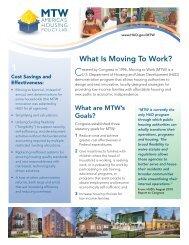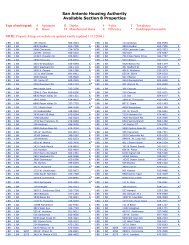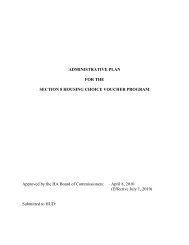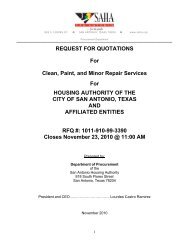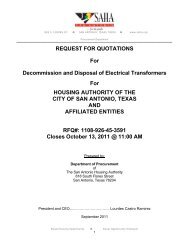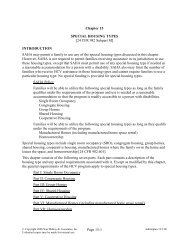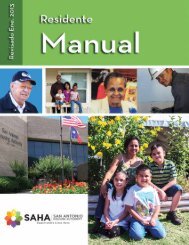AGENDA - San Antonio Housing Authority
AGENDA - San Antonio Housing Authority
AGENDA - San Antonio Housing Authority
- No tags were found...
Create successful ePaper yourself
Turn your PDF publications into a flip-book with our unique Google optimized e-Paper software.
SAN ANTONIO HOUSING AUTHORITY May 16, 2013MEMORANDUMTo:From:Presented by:Operations and Human Resources CommitteeLourdes Castro Ramirez, President and CEORichard Milk, Sr. Planning & Policy ManagerSubject:Update and discussion regarding 2013 Demographic Report____________________________________________________________________________SUMMARYThe 2013 Demographic Report provides summary information and maps describing thehouseholds that receive assistance from SAHA’s public housing and assisted housingprograms. This report is designed to be updated annually in order to identify demographictrends over time. The 2013 Demographic Report, being the first of the series, establishesbaselines against which future trends can be compared.The report includes several maps in order to highlight the geographic characteristics of thehouseholds who receive assistance through SAHA programs. Difference in location anddistribution can illuminate current conditions and inform future policies.Snapshot data used for this report is intended to be used for planning purposes only. SAHA isunder various local, state, and federal reporting requirements that have individual dataextraction methods. As a result, data reported for those purposes may slightly differ from thedata explored in this report.General Household CharacteristicsNearly all households assisted by SAHA are extremely low-income or very low-income (30%and 50% of area median income, respectively). A majority of households are headed by a singlefemale and have children. A large percentage of households have at least one member who hasa disability. These characteristics are similar to household characteristics drawn from a nationalsample.Assistance and High Poverty NeighborhoodsThere is striking difference between public housing and vouchers when households and childrenare overlaid with high poverty neighborhoods (see maps 1 and 2). Households in public housingare more than three times as likely to live in a high poverty neighborhood compared to voucherhouseholds; and public housing children are five times more likely than voucher children to livein these areas. Twenty-two (22) percent of SAHA’s households live in high povertyneighborhoods, and over 26% of children are living in high poverty neighborhoods.TenureOverall, households in both programs have similar median tenures, 5.5 years for vouchers and4.9 years for public housing. By mapping median tenure by census tract, pockets of longer andshorter tenures can be observed. Tracts with larger public housing family communities on thenear west side have a shorter tenure than average, while tracts with smaller public housingelderly and disabled communities have a longer tenure than average.



